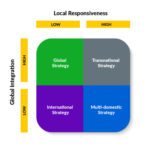




Global expansion offers a wealth of opportunities. Yet like any business endeavor, it's fraught with risks and challenges. From local laws to language barriers, companies that "go global" must learn to navigate new markets.
So, it should come as no surprise that even leading companies have failed international expansion attempts. Fortunately, you can increase your odds of success with some strategic planning.
In this article, we cover when to expand, how to plan a business expansion, and the advantages and disadvantages of entering a new market. But before we dive in, let's start with a definition.
Global business expansion is a growth strategy that involves establishing business operations in foreign markets.
Businesses choose to expand when they want to generate more profit or in response to increased competition, domestic success, and potential in new markets.
Given that international expansion is a major undertaking, it's important to determine whether your business is ready before you take that step. Below are six indicators that it may be the right time to establish business operations abroad:
If any of these apply to your business, you could find success in market expansion. Here are some key considerations before you implement an international expansion strategy.
The first step is to determine which of the four strategic models aligns with your business needs and goals. Keep in mind that the model you choose may require you to adapt business operations to meet local regulations.

An International Strategy is usually the first approach a business takes. It focuses on exporting or importing goods while maintaining a headquarters in the domestic market. This requires lower integration and lower responsiveness, similar to an export strategy. Companies that use an international strategy include Harley Davidson, Rolex, and Lindt AG.
Entry strategies include:
A Transnational Strategy involves operating out of a headquarters in one country which coordinates any subsidiaries in other countries. It requires high local responsiveness and high global integration as well as customizing products to meet local demands. Examples of this are Coca-Cola, Unilever, and KFC.
Entry strategies include:
A Multidomestic Strategy involves using different sales, marketing, and product strategies based on the companies a business is operating. Instead of operating as one global brand, a business develops smaller, country-specific brands that have been adapted to local preferences. It requires high local responsiveness and low global integration. Companies that use a multidomestic strategy include Heinz, Netflix, and Nestle.
Entry strategies include:
A Global Strategy involves defining one global brand and making few to no changes for other markets. This strategy works well for industries where local preferences are less important than costs, e.g., software and technology. It requires lower local responsiveness and higher global integration. Companies that use a global strategy include Microsoft, Procter & Gamble, Intel, and Lenovo.
Entry strategies include:
Once you've chosen a business expansion model, you need to conduct market research to learn more about your target customers. This will help you improve the customer experience and identify key points in the buyer journey. Common market research strategies include:
Market research will also help you create buyer personas for the new market, and successfully adapt your brand identity through website localization.
Before you enter a new market, be sure to understand that country’s language access laws. They may have business regulations that differ from your own. To ensure compliance, consider:
As you expand your businesses' reach, you'll also need to expand your team. That means hiring employees or subcontractors who can respond to international inquiries, understand local markets, and know how to capitalize on the weakness of local competition. Yet finding the right people can be difficult to do remotely due to geographical, cultural, and language barriers.
An international PEO can help you establish a presence in a new market. The organization you hire will help you manage recruitment, HR, payroll, and taxes, while allowing you to remain agile enough to exit the market, if necessary.
Local language and culture have a significant impact on how your brand is perceived by a targeted audience. This is where website translation and localization come in. Though these terms are often used interchangeably, they are two distinct processes in a global marketing strategy.
Website translation is the process of rendering text from one language into another and is an important aspect of localization.
Website localization involves more than just translation. It is the process of adapting products, services, marketing, and other content for a target market and includes customizing these elements with a look and feel that matches local cultural preferences. For example, website localization involves:
As a part of your non-web content adaptation strategy, you may need to engage in a technique called transcreation. this involves reimagining your message to preserve the intent, context, and tone in the new language. This type of translation is usually not word-for-word and leaves room for creative interpretation.
At MotionPoint, we work with you to develop a strong localization strategy to maximize your success in a new market. Our technology and services til lokalisering af hjemmeside give you the tools you need to adapt your message in any language, quickly and affordably.
Now that you know more about global expansion, let’s take a look at a few of the advantages and disadvantages of doing so.
Advantages include:
Disadvantages include:
Ultimately, whether or not you decide to expand globally will depend on your business goals and stage of development. If the time is right for you, MotionPoint can provide the translation and localization services you need to connect with international customers.
For a limited time, take advantage of our amazing BOGO offer! If you want to test out a new, foreign market like Mexican Spanish, why not try out Spanish for South American markets? If you sign up to get one language, we’ll give you the second for free! Drop us a line today.